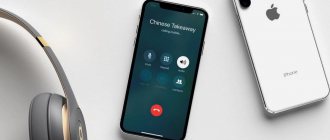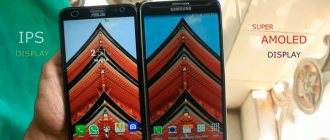If you are reading these lines, it means you want answers to two questions. Which type of screen is better, IPS or AMOLED, and what are the advantages and disadvantages of the first type of matrices, that is, IPS LCD screens. In this publication we will clearly answer both questions, and at the same time tell you a lot of interesting things about IPS screens and the smartphones in which they are installed!
Which is better, IPS or AMOLED
Without philosophical introductions, we begin to answer the questions asked. If we were to choose a winner between an AMOLED or IPS screen, we would bet on AMOLED. Whatever one may say, good Amoled displays are still better than good IPS matrices. We are ready to give strong arguments in favor of this statement. Advantages of AMOLED screen:
- Perfect black color.
- Large reserve of brightness.
- Maximum image contrast.
- Minimum response time.
- Wide range of possibilities when designing smartphones.
The last point requires a little explanation. AMOLED, unlike IPS screens, can be bent. This opportunity is often used by leading companies when developing flagship devices. In addition, only the Amoled matrix allows you to install an on-screen fingerprint sensor (integrated into the display) into the phone. An IPS screen does not provide such an opportunity, at least at this stage of technology development.
OLED displays
OLED displays are a separate segment, representing one of the most promising areas.
OLED device. Photo www.flatpanels.dk
OLEDs are organic light-emitting diodes that independently emit light when electric current passes through them. In English, this abbreviation stands for Organic Light Emitting Diod.
If translated into Russian, the result will be light-emitting organic displays. Organic does not mean “living”. Here, organics refer to carbon-containing polymers that phosphoresce when a current is passed through them. Moreover, they glow the brighter the more current is applied to them. If no current is supplied at all, there will be no glow.
OLED technology has surpassed LCD and LED in many ways. Until recently, matrices based on organic light-emitting diodes were found only in smartphones and TVs. In 2022, ASUS began producing laptops with OLED displays.
- Advantages: light weight, dimensions; low power consumption; any geometric shapes; viewing angles up to 180 degrees; instant response; contrast exceeds all known alternative technologies; temperature range is wider than other screens.
- Disadvantages: short service life; high price.
IPS screen matrix - second grade?
In no case! The IPS screen matrix has a number of advantages, which we will definitely talk about in more detail. For example, it is “healthier” for the eyes; at least, it is not as dangerous to eyesight as an Amoled display of poor quality. Only an IPS screen allows you to get perfect white color, and in general this type of matrix has more accurate color reproduction. True, with color rendering, not everything is as good and cloudless as is commonly thought.
The main idea of this section of the article is that the IPS screen matrix is not much inferior to an Amoled display, and in many respects even surpasses it. Yes, if we were to choose the best technology, we would choose Amoled, but only with three important caveats:
- Many experts will disagree with us and prefer an IPS screen.
- The difference is not so great as to put an end to IPS LCD screens. Many people won't notice this difference at all.
- In a number of parameters, the IPS screen is better, and we will discuss this in detail in the next section.
What is LCD
LCD is an abbreviation for Liquid Crystal Display, which in Russian means liquid crystal display. This explains the unspoken name of such matrices - LCD. Thus, almost any screen that you have in your home - a monitor, a TV, a mobile phone, and even screens on household appliances - is an LCD. At the moment, LCD screens are most widespread all over the world, as they have a lot of undeniable advantages, while they are accessible and inexpensive. The only competitor to such screens is the plasma panel, but such screens are slightly more expensive than LCD.
What's better than an IPS screen?
So, what is better than an IPS screen? If you've read other articles on this topic, you've probably come across a statement about color accuracy. Indeed, the IPS screen matrix allows for maximum accuracy in displaying tones and shades. But here, as in most cases, important remarks need to be made.
IPS screen color rendition
Perfect color reproduction on an IPS LCD smartphone screen is rare. Typically the color temperature moves towards the cooler end of the spectrum and the display appears blue. Truly gorgeous color reproduction is provided by Professional IPS, or P-IPS, which displays 102% of the color space and conveys more than 1 billion shades. Such matrices are installed in expensive monitors used by designers, photographers and representatives of other professions for which accurate color rendition is critical.
IPS smartphone screens are not equipped with such expensive matrices; By the way, the average cost of an IPS LCD phone screen with Full HD resolution is about $10. But this does not mean that a phone cannot have good color reproduction in principle. Vice versa! For example, the new Xiaomi Mi 8 Lite in Standard Mode produces an almost perfect picture with minimal color deviation. The phone is equipped with an IPS screen, and in terms of color reproduction it is ahead of almost all 2018 flagships equipped with Amoled matrices.
Perfect white color
Liquid Crystal Display (LCD) technology allows you to obtain perfect white color. Not almost perfect, but flawless. Of course, in smartphones, white shades often give off blue or green, but this is also typical for Amoled displays, on which pure white is impossible to obtain in principle.
The IPS LCD screen makes it possible to get perfect white, and with good factory calibration of the smartphone display, this becomes noticeable. This advantage can be of great importance for those who read a lot on a smartphone, meticulously study photographs, or actively use instant messengers in which a white background predominates. On the other hand, when watching a video, ideal white does not play any role, since you won’t even notice it in the general mix of colors.
IPS LCD screens do not have PWM
The main problem with Amoled displays is flickering, which is caused by changing the backlight frequency to adjust image brightness. You can read more about this in the article dedicated to the pros and cons of Amoled screens, but here we will focus on the main thing.
Screen flickering at frequencies above 250 or 300 hertz does not affect vision in any way. It is impossible to notice it with your eyes. But if the frequency decreases, flicker leads to eye fatigue and even worsening vision. It is noteworthy that you still cannot see the PWM with the eye, but it can be easily identified using a simple “pencil test”. (The test can be carried out even now; the technique is described in the article about Amoled screens).
The IPS LCD screen of the smartphone also flickers, but at a higher frequency. This flicker does not have any effect on vision. You can compare PWM Amoled and IPS screens using the same “pencil test”; to do this, just take two phones with different matrices. If there is no such pair at home, you can go to the nearest electronics store.
IPS screen lifespan
One of the main arguments against Amoled screens is their “fragility”. They tend to fade and lose brightness as they wear out. IPS LCD screens have a long service life. The matrix is designed for tens of thousands of hours of operation; the maximum brightness of the smartphone screen will not change even after 5 years of active use.
In practice, the situation looks a little different. There really are no problems with the service life of IPS screens; they do not fade or become paler. Yes, the IPS matrix may initially be dim, but that’s another story, we’ll come back to it later.
The nuance is that good Amoled screens also do not fade, at least they will definitely last for the life of the phone. The problem may appear if you buy a cheap phone with an Amoled display, for example, some Galaxy J6 2022, ZTE nubia M2 or Umidigi Crystal. We are not saying that the screens of these particular smartphones will burn out in a year. But we have real examples where the Amoled screen of a Samsung J series phone burned out in 7-8 months.
Simply put, if you are buying an inexpensive smartphone, it is better to buy a device with IPS LCD. A cheap Amoled matrix can really burn out after a year. But flagships with Amoled will delight you with a bright picture until you want to change your phone.
LCD Monitor Settings
Despite the fact that the cell response time is far from the most important indicator, most often when choosing a monitor the buyer pays attention only to this factor. Actually, this is why TN+film dominates. However, when choosing a specific model, you should carefully weigh all the characteristics of the monitor.
Response time
This indicator means the minimum time during which a cell of a liquid crystal panel changes color. There are two ways to measure the speed of the matrix: black to black, black-white-black, and gray to gray, between shades of gray. These values vary greatly.
When the state of the cell changes between the extreme positions (black and white), maximum voltage is applied to the crystal, so it rotates at maximum speed. This is how values of 8, 6, and sometimes 4 ms are obtained in the characteristics of modern monitors.
When the crystals are shifted between shades of gray, much less voltage is applied to the cell because they must be positioned precisely to obtain the desired shade. Therefore, much more time is spent for this (for matrices 16 ms - up to 27-28 ms).
Only recently have they been able to implement a fairly logical way to solve this problem in final products. The maximum voltage is applied to the cell (or reset to zero), and at the right moment it is instantly brought to the desired position to hold the crystal. The difficulty is precise control of voltage with a frequency exceeding the sweep frequency. In addition, the impulse must be calculated taking into account the initial position of the crystals. However, Samsung has already presented models with Digital Capacitance Compensation technology, which gives performance of 8-6 ms for PVA matrices.
Contrast
The contrast value is determined by the ratio of the brightness of the matrix in the “black” and “white” states. Those. The less the black color is overexposed and the higher the brightness of the white, the higher the contrast. This indicator is critical for viewing videos, images and, in principle, for the good display of any image. It looks like, for example, 250:1, i.e. The brightness of the matrix in the “white” state is 250 cd/m2, and in the “black” state – 1 cd/m2. However, such values are only possible in the case of TN+film; for S-IPS the average value is 400:1, and for PVA – up to 1000:1.
However, the values stated in the monitor's characteristics should be trusted only with a stretch, because this value is measured for the matrix , and not for the monitor. And it is measured on a special stand, when a strictly standard voltage is supplied to the matrix, the backlight is powered by a strictly standard current, etc.
Brightness
Measured in cd/m2. Important for working with images, for colorful games and videos. Depends on the power of the backlight and, indirectly, on the type of matrix (remember the disadvantages of S-IPS?).
Viewing Angles
Usually the values 170°/170° are indicated, however, for TN+film this value is nothing more than a declaration. The requirement when determining viewing angles is to maintain a contrast ratio of at least 10:1. At the same time, color rendering in this position is absolutely indifferent, even if the colors are inverted. We also take into account that the angles are determined in the center of the matrix, and we, naturally, initially look at the angles at an angle.
Color rendition
Before crossing the 25 ms mark when switching a cell in the black-white-black order, all TN matrices displayed fair 24-bit color. However, in the speed race, AU Optronics decided to discard honest color rendition. Starting with 16ms matrices, all TN+film only provide 262k shades (18-bit). A larger number of shades is provided in two ways: either by mixing dots with different colors (dithering), or by changing the cell color each time the picture is updated (Frame Rate Control, FRC). The second method is more honest, because the human eye still does not have time to notice the color change on each frame. We emphasize that all TN+film matrices faster than 16 ms are 18-bit; most matrices produced using other technologies support 24-bit color reproduction. The exception is the PVA found in some Samsung monitors, so be careful when choosing. Unfortunately, Samsung cannot trace any system in the installation of 18- or 24-bit PVA.
IPS LCD screen: disadvantages
The advantages of IPS LCD screens have been described in all colors, it’s time to talk in more detail about the disadvantages, otherwise the picture will turn out to be incomplete and biased.
Gray instead of black
The IPS LCD screen is built on liquid crystals that rotate to display the desired colors. The crystals themselves, unlike the LEDs of an Amoled display, are not a light source, so in the IPS matrix the entire screen is illuminated. “Closed” crystals that transmit black also transmit light to some extent, and therefore it is impossible to get perfect black on IPS. In this, this type of matrix is really inferior to Amoled.
Due to the lack of absolute black color, maximum contrast suffers, and this leads to one of the main problems of smartphones with IPS screens - poor readability in the sun. Bright matrices with good backlighting provide acceptable readability, but in this regard Amoled is always ahead: good Amoled screens are readable in the sun better than good IPS ones, the power ratio does not change in the category of budget or reference displays.
Response time
The inertia of an IPS LCD matrix is much higher than an Amoled screen, which is explained by the need to “turn over” the crystals. Of course, this process happens quickly, but in this case the count is in milliseconds, and these milliseconds matter.
The response time of a modern IPS screen in a smartphone is about 5 ms. If you use your phone for reading, social media, or watching YouTube videos, response time doesn't matter, but for virtual reality, which is rapidly gaining popularity, slow-responsive screens aren't ideal. For comparison, the response time of the Amoled matrix does not exceed 0.1 ms.
Thickness
To some, this drawback of an IPS screen will seem insignificant, because even a “thick” IPS LCD smartphone screen actually remains very thin, but thickness still matters. Such screens cannot be bent; you can only imitate the 2.5D effect using glass; the display itself remains flat. Amoled screens really bend, which is actively used by leading brands when creating flagship models. Notable examples are Huawei Mate 20 Pro or Galaxy S9+ with Infinity Display.
Another nuance is that the currently fashionable technology with an on-screen fingerprint sensor cannot be implemented in a phone with an IPS screen. Just the other day, Honor View 20 was released, and many users criticize the new product for the “unaesthetic” scanner on the back cover. Apparently, they are not aware that a screen sensor cannot be installed in a phone with an IPS matrix, at least at this stage of technology development.
Brightness deficiency
The low brightness margin is another drawback. Although it is not found in all smartphones with an IPS screen, when directly comparing IPS and AMOLED, the former usually appears dim. If you often watch videos and want to enjoy the most juicy picture possible, this fact is worth taking into account.
TN matrix
By applying voltage to the electrodes, you can change the angle of rotation of the crystal until it is completely straightened, at which light passes through the crystal without refraction. And since it was already polarized by the first filter, the second one will completely delay it, and the cell will be black. Changing the voltage changes the angle of rotation and, accordingly, the degree of transparency.
TN+Film matrix. It differs from simple TN by the presence of a special layer designed to increase the viewing angle in degrees. In practice, a value of 150 degrees horizontally is achieved for the best models. Used in the vast majority of budget-level TVs and monitors.
- Advantages: low response time, low cost.
- Disadvantages – small viewing angles, low contrast, poor color rendering, inertia, power consumption
Results: IPS or AMOLED
We have examined in some detail the pros and cons of an IPS screen; it’s time to repeat what we have covered in the form of traditional conclusions and give some recommendations. So, this type of matrix can offer excellent color rendering in combination with the absence of flicker, perfect white color and long service life. The downsides are that blacks on IPS matrices usually look gray, there is often not enough brightness headroom, and the response time leaves much to be desired, at least when compared with AMOLED.
Now let’s answer another important question: in what case should you choose a phone with an IPS screen? In our opinion, the choice in favor of this technology should be made in the following situations:
- You are buying an inexpensive phone . IPS will be the right choice because cheap Amoled can burn out quickly and will flicker a lot.
- You often work with text . If you constantly communicate in instant messengers, read and type text, it is better to buy a smartphone with an IPS matrix. This type of display is better suited for reading text. The lack of PWM is one of the main reasons for this.
In addition, if you are satisfied with the softer and more natural colors of an IPS screen, there is no point in chasing Amoled, which has a more aggressive and rich picture. On the other hand, if you often and for a long time watch videos on your smartphone, and want to see the most contrasting and bright image possible, you need to take a phone with Amoled.
That's all. If you have questions or comments, write comments. And subscribe to our Instagram to quickly receive the main news from the world of smartphones!
Table of advantages and disadvantages of modern monitor matrices
| Matrix type | Advantages | Flaws |
| Low response time (up to 1 ms), low cost | Small viewing angles, low contrast, poor color rendering, inertia, power consumption | |
| IPS | Large viewing angles, very good color rendering (DCI-P3 and Rec. 2020) | High price, high response time (5-15 ms), poor blacks |
| Low response time (up to 2-3 ms), high refresh rate (up to 200 hz), good color rendition, better contrast (3000:1) | Cropped viewing angles | |
| OLED | Low power consumption, large viewing angles (up to 180 degrees), instant response, high contrast | Short lifespan of diodes, high price compared to IPS, impossibility of creating a durable display |
Well, let’s now consider the evolutionary process that displays went through when they came to serve humanity.











